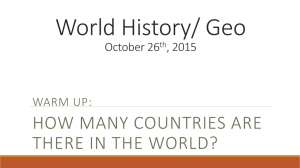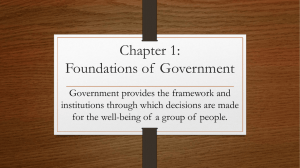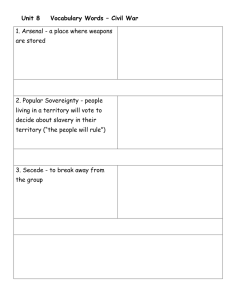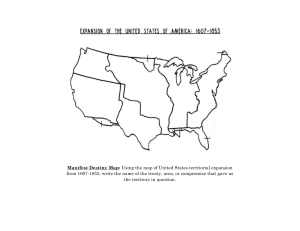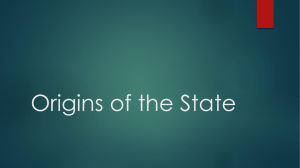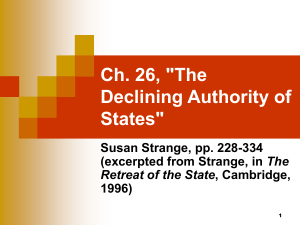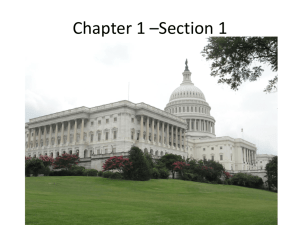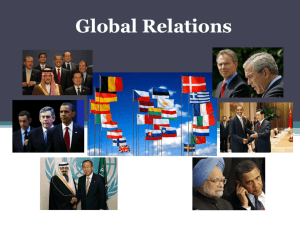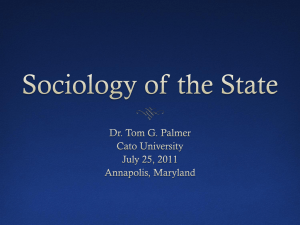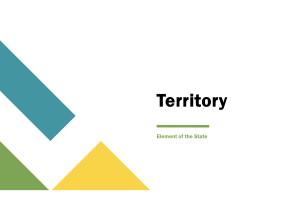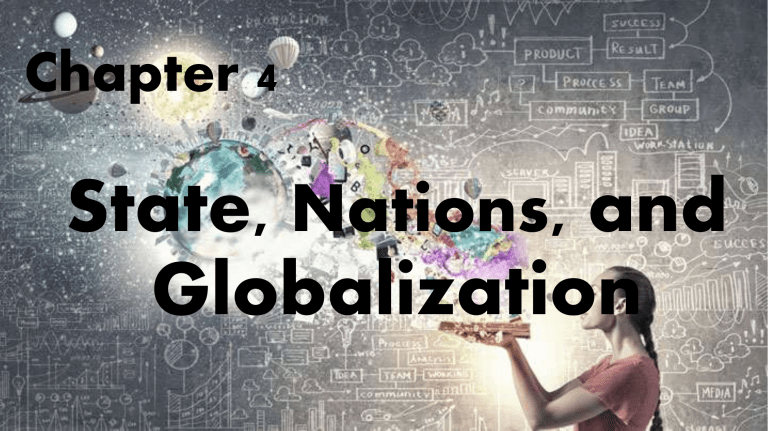
Chapter 4 State, Nations, and Globalization “As we have seen, the wireless and airplane have made the world so small and nations so dependent on each other that only alternative to war is the United States of the World.” John Boyd Orr State What is State • Groups of people which have acquired international recognition as an independent country and which have a population, a common language and a defined and distinct territory. • A state is an organized political community living under a single system of government. “A state is a community of persons more or less numerous, permanently occupying a definite portion of territory, independent of external control and possessing an organized government to which the great body of inhabitants render habitual obedience.” - Gardner Four Elements of States 1. Population -the State is a human institution. Hence population is it’s first and foremost element. -No state can be imagined without the people, as there must be some rule and others to be ruled. -State is a community of persons. It is a human political institution. Without a population there can be no State. Population can be more or less but it has to be there. “A good citizen makes a good state” -Aristotle 2.Territory -People cannot constitute a state,unless they habbit in a definite territory. -Territory is its “material basis” The territory of the state comprises: • Land, mountains, rivers and lakes within its frointers, • Territorial water, extending six miles into the sea from the coast • Air, space,lying above its territory. • A geographical contiguous territory is an asset;otherwise it creates problems of administration and control. • Any interference with rights of one state by others may lead to wars. • This is the rationale of the idea containeb in the concept of Respect for Territorial Integrity and Sovereinty, Art.1 Sec. 1 1997 Constitution NATIONAL TERRITORY The national territory comprises the Philippines archipelago, with all the islands and waters embraced therein, and all other territories over sovereignty or jurisdiction, consisting of its terrestrial, fluvial and aerial domains, including its territorial sea ,the seabed, the subsoil, the insular shelves and other submarine areas. The waters around, between and connecting the island of the archipelago, regardless of their breath and dimensions form part of the internal waters of the Philippines. The Archipelagic Principle of Territoriality • An Archipelago is defined as a sea or part of a sea studded with the islands, often synonymous with island groups, or as a large group of islands in an extensive body of water, such as sea.( Deleon, 1997) • In various conference of the United Nations on the Law of the Sea,the Philippines and other archipelago states proposed that an archipelago composed of goups of islands forming a state is a single unit ,with the islands and the waters within the baselines are internal waters - Internal Waters are the waters Around, Between and connecting the islands of the archipelago, regardless of their breath and dimension. Other Territories over the Philippines has Sovereinty or Jurisdiction • Any territory that presently, belongs or might in the future belong to the Philippines through any of the accepted any of the accepted international modes acquiring territory. TERRITORIAL SEA – The belt of the sea located between the coastal state qon the hand and high seas on the other extending up to 12 nautical miles from the law water mark. • EXCLUSIVE ECONOMIC ZONE – body of water extending up to 200 nautical miles,within which the state may sovereign rights to explore, exploit, conserve and manage the natural resourses. The state in the EEZ exercises jurisdiction with the regard to: 1. The establishment and use of the artificial islands, installations, and structures; 2. Marine scientific research; 3. 3.The protection and preservation of marine environm 3. Government • A community of persons does not form a state unless it is organized by established government. Government usually consists of three branches: 1. Legislature an elected group of people who have the power to make and change laws in a state or country. 2. Executive someone in a high position, esp. in business, who makes decisions and acts according to them. 3. Judiciary the part of a country’s government that is responsible for its legal system and that consists of all the judges in its courts of law Purposes and Objectives of the States that the Government Seeks to Attain a. Domestic Order and Tranquility The primary purpose of the state that its government seeks to achieve is the maintenance of domestic order and tranquility. b. Common Defence of the States Concominant with maintenance of domestic order and tranquility, the government also undertakes to defend the state from external aggression. C. Blessing of Liberty and Justice The third objective of the state is to secure for the people the blessings of liberty and justice. Life, liberty and the pursuit of happiness are the inalienable rights of man. The freedom of association, freedom of religion, and the rights of person accused of crimes should not be subject to restrants. D. Promotion of General Welfare the government undertakes this by performing service functions, like the creation of essential public service, promotions of health and sanitation, regulations of business and dissemination of public information. E. Promotion of Public Morality the state is concerned with value judgments and moral standards. Government should set one code of moral conduct for all, including officers. 4.Sovereignty • This is the power of the state to command and enforce obedience of its will from people. • It means power over people of an area unrestrained by laws originating outside the area or independence completely devoid of direct external control. There are four kinds of sovereignty: A.Legal sovereignty Is the authority which has the power to issue final commands. This is the supreme power B.Political sovereignty Is the power behind the legal sovereignty or the sum of the influences that operate upon it. In a narrower sense electorate constitutes the political sovereignty and in a broader sense the whole mass of population. • C. Internal sovereignty Refers to the power of the state to control its domestic affairs. D.External sovereignty Is the power of the state to direct its relations with other states. The state is not subject to the control dictation, or government of any power. Emergence of the Modern State System The modern state system emerged in Europe between the start of the 12th century and the end of the 17th. States began to replace existing forms of political organization in the late Middle Ages in Europe when key actors, responding to a diverse set of political and economic incentives, formed coalitions that undermined one set of political arrangement, feudalism and gradually replaced it with another, the sovereign state. • Feudal arrangements were the person commitments by individual lords and vassal. • Public power and authority –including the military -held by private individuals. Two Internal sources of pressure Destabilize the Feudal System. • The first was a centuries-long conflict between the pope and the holy roman emperor ,which exhausted the only two claimants increase to universal authority in medieval Europe. • The second was a large and sustained increase in trade, which led to an increase in the number of new actors: Peace of Westphalia (1648) Thirty years War, created a set of agreedupon principles for legitimate rule that provided the first normative basis for modern state system. The Westphalian system of sovereign states It is established in 1648 as part of the peace of Westphalia . Three core points to treaty : 1. The principle of state sovereignty 2. The principle of (Legal) equality of states 3. The principle of non-intervention of one state in the international affairs of another
